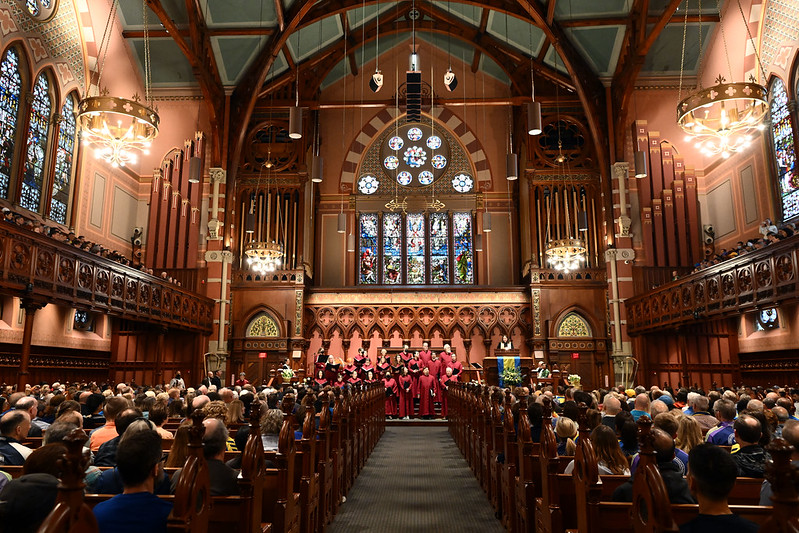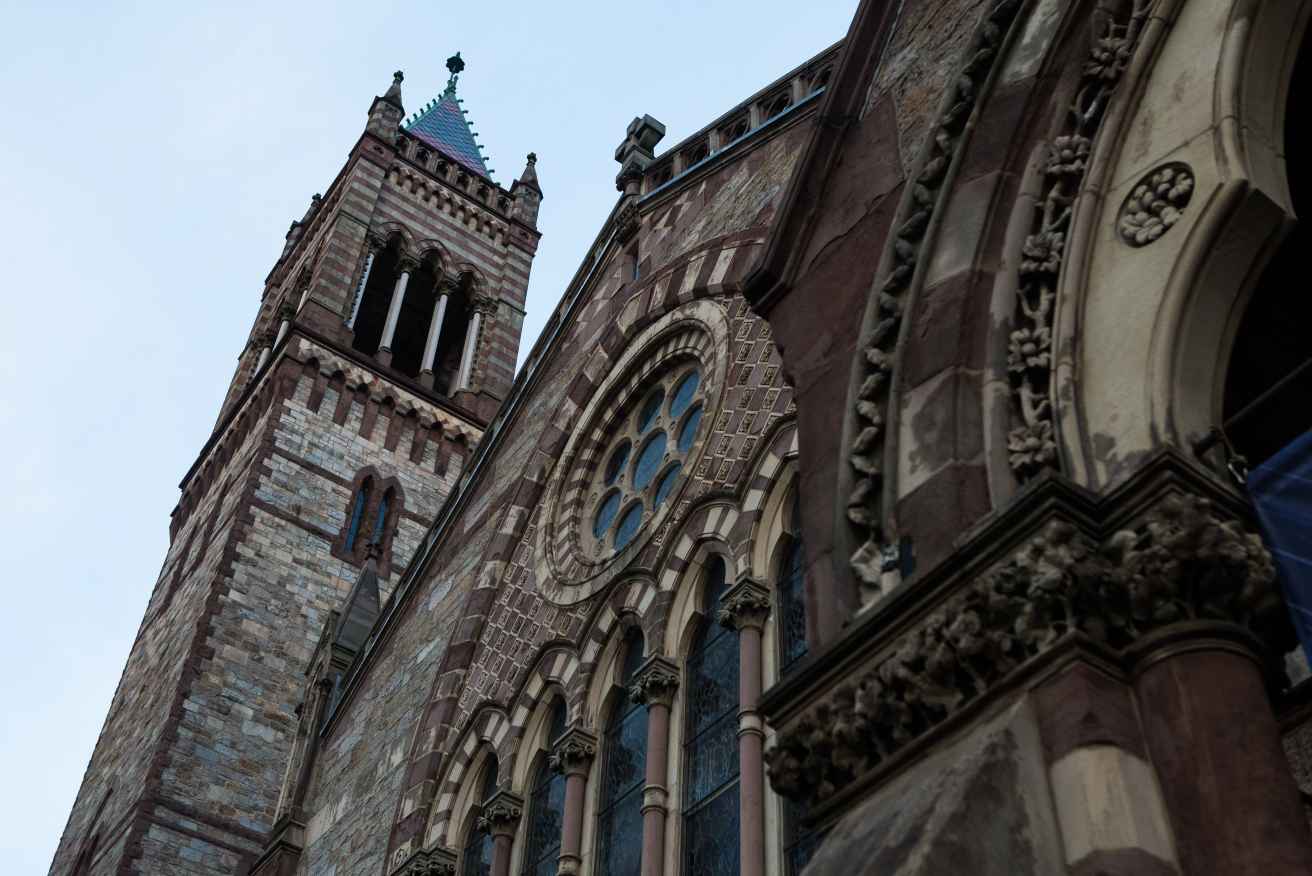Festival Worship
Festival Worship
Bone
Transcript
Will you pray for me? Lord, may the words of my lips and the meditations of all our hearts be acceptable in your sight, our Rock and our Redeemer. Amen.
So the Spirit of the Lord picks Ezekiel up, takes him out, and sets him down in the middle of a valley, and everywhere he looks: bone upon bone upon bone, dry as the dust. Some are skeletons still lying where their former owners fell. But there are also great stacks of long bones, and pyramids of skulls, tangled piles of pelvises and rib cages. Tiny, unidentifiable bits litter the ground as far as the eye can see.
Picture it: femurs as long as Ezekiel himself lean up against giant skulls with 11-foot-long tusks. Saber-sized fangs protrude from long jaws with rows of vicious teeth designed to rend and tear. Segments of yards-long tails lie next to armored carapaces as big as VW Beetles. Words like “behemoth” and “leviathan” come to Ezekiel’s mind, but there are smaller things, too, not just internal bones, but pieces of exoskeletons as well; he wades through piles of tiny cast-off insect skins and seashells, beautiful corals and microscopic diatoms, long segmented carapaces with dozens of legs.
And here and there amidst the piles, he notices skulls that could almost—almost—have been from someone Ezekiel knew, but nobody Ezekiel knew had such a shallow brain pan, such a brow ridge, so flat a nose, or upper and lower jaws that protruded so far. So many impossible bones.
++++++++++
Almost from the moment this vision was written down, we have been wondering where that valley of bones is. Of course, since it’s a vision, it might not be anywhere except in Ezekiel’s mind, but people have always speculated on whether this valley would have been familiar or recognizable to Ezekiel’s first hearers. Some say it was the Hinnom Valley just outside the oldest part of Jerusalem, where people had performed human sacrifices once upon a time. The Israelites were in exile in Babylon when Ezekiel was writing, so some scholars say it would have reminded those first hearers of some terrible place they knew from their days in that far land. Still others say it must have referred to some great battlefield strewn with bodies left to rot.
I say none of those scholars has enough imagination.
They hear that there was a field full of dry bones, and they immediately assume it must have been a bunch of human bones that Ezekiel saw. They hear God speak of “the house of Israel” and “my people”, and they think that can’t mean anything other than the ancient Nation of Israel, while in the Bible, “Israel” can refer to any group beloved of God. They hear a story about resurrection, and assume that humans are the only things that have ever lived on the planet that God would waste the energy on.
But this is the God that made every living thing—every living thing—from the dust with her own hands. If Jesus was right, if that God notes the fall of every sparrow, don’t you think that she would notice a mastodon crashing to the ground? Don’t you think he would notice a saber-toothed tiger, or a giant ground sloth, thrashing in a tar pit? Don’t you think that God would notice the fate of the hominid Australopithecus afarensis just as keenly as that of the hominid Homo sapiens?
Now, I don’t know what valley Ezekiel was actually looking at in his vision, or what kind of bones. Then again, neither do you. So here’s what I think he saw. I think he was standing right in the middle of Los Angeles, California, looking right down into the LaBrea Tar Pits at the bones of the imperial mammoth, the American camel, the saber-toothed cat and the American lion.
I think he was standing in Olduvai Gorge on the Serengeti in Tanzania, looking down at layer upon layer upon layer of sedimentary deposits, at the bones of our ancestors Paranthropus Boisei and Homo habilis, at their tools and the campsites where they lived and loved and died.
I think he was standing on the hill in my cousin’s back yard, looking down at the stream where I found all those trilobite fossils as a child.
So many bones. Or maybe not only bones, strictly speaking. Maybe so many skeletons, both exo and endo, so many bits and pieces, so many traces of so many lives.
++++++++++
Over the course of the world’s 4.54 billion-year history, there have existed something like 50 billion different species. And someone standing at LaBrea, or Olduvai, or my cousin’s back yard can tell you this: something like 99% of that 50 billion are now extinct1. Paleontologists often quip that if you compare the number of species that exist today to the number that have existed throughout history, then all life today amounts to little more than a rounding error.
Historically and mathematically speaking, any one species, including ours, is more likely to become extinct than to survive, and even the ones that survive will probably evolve into something completely other than what they were. And the new kids on the block will take up the metaphorical bones the oldtimers left behind, the DNA they passed on and the atoms their bodies returned to the earth, they will take those bones up and use them to build new life.
Now, extinction is always going on for one reason or another, but geologists and paleontologists believe that five times in earth’s history there have been events that precipitated rapid die-offs, mass extinctions in which the majority of all life on earth disappeared.
The most recent of these mass extinctions was 65 million years ago, when an asteroid 6 miles across slammed into the earth near the present-day town of Chicxulub on Mexico’s Yucatan peninsula. So cataclysmic was this impact and its effects that 75% of all species on earth disappeared forever. 75% of all life went down to bones and dust at once. Although actually, only some left behind bones; most just ceased to exist. Among the lost: the dinosaurs. The vacuum created by their absence allowed, over millions of years, for the rise of the mammals, who eventually gave rise to the hominids, who eventually gave rise to Homo habilis, who eventually gave rise just a second ago, just 200,000 years ago, to Homo sapiens. Who eventually gave rise to Ezekiel and you and Jesus Christ, whose death we mourn.
++++++++++
Here’s why I bring this up today: today we join in the ancient tradition of celebrating the fifth Sunday of Lent as Passion Sunday, when we remember the suffering and death of Jesus Christ on the cross, and when we pray that God will help us stand in solidarity with any—any at all—who suffer and die unjustly or needlessly.
Passion Sunday’s the best Sunday I can think of to tell you this: scientists generally agree that we are in the midst of a sixth mass extinction. Of course estimates vary, but a fairly middle of the road estimate is that by the end of this century, something like 50% of currently existing species will have gone down to bone and dust. And for the first time ever, the cause of this mass extinction will not be a geologic or meteorological event; it will be one of the species themselves.
Within a couple of hundred years of the first humans’ arrival on Madagascar, all of its large animals were hunted to extinction.
The Eastern Cougar was declared extinct earlier this year.
Amphibians around the world are right now in a precipitous decline. Habitat loss and chemical poisoning are part of the problem, but the main culprit is a fungus spread around the world literally on the backs of South African frogs that doctors exported for use in medical testing in the first half of the 20th century.
Bat populations in the eastern half of North America are in serious decline after a different fungus, quite possibly introduced through a tourist cave in Upstate New York, has begun attacking them.
The list, as you know, goes on. But the scariest part is this: the last time carbon dioxide levels spiked the way they have in the past century? The last time there was this much carbon in the atmosphere and the chemistry of the oceans changed as much as we’re changing it right now? They call the last time that happened “The Great Dying”. It was the third of the five major mass extinctions, about 250 million years ago, and it was the result of a massive series of volcanic eruptions that covered huge areas of Siberia with basalt and spewed untold amounts of CO2 into the air, only a little faster than our cars and factories and power plants are. Over 90% of all ocean species, and 70% of all land species, did not survive those changes.
[pause]
So the Spirit of the Lord picks Ezekiel up, takes him out to a valley of bones, and says, “Prophesy to the bones”, and Ezekiel does, and the bones come together and are covered by flesh. The Spirit says, “Prophesy to the breath,” and Ezekiel does, and the breath of life flows into them, and God promises to return them to the land.
Here’s what the story says: that dry bones are not the final state of things. That death and decay will not finally reign. That extinction will not win. Here’s what it says: life wins.
Here’s what it doesn’t say: that the bones went back together in their original order. Here’s what it doesn’t say: that the bodies at the end were the same as the bodies that owned the bones in the first place.
After each of the great mass extinctions, life did indeed bounce back. The great evolutionary processes of genetic mutation and natural selection made sure that the building blocks of life came together in new ways, and when the breath went back into those bodies, new forms of life, better suited to new circumstances, arose from the old building blocks. If some species left forever, others arose to take their place. The trilobytes go down into the ground, and rise up again as the dinosaurs. The dinosaurs go down to bone and dust, and mammals spring up to take their place. The bones lie scattered in the valley, and the Spirit blows into them until they rise to own the future. The Son of God goes down into the valley of bones, and rises up the King of Heaven.
So make no mistake: life will win no matter what we do to the planet. That giant asteroid that landed in Mexico? Its impact would have released as much energy as several million nuclear warheads detonating at once. Even we, even we would have a hard time doing that much damage to the planet. And still life won, which it will always do as long as God is around, which will be forever.
But here’s the thing: life won, but only after a lot of terror, pain, and death. Life won, but only after some of God’s favorite creations were lost forever. In geologic terms, in the long view, life wins. But in the meanwhile, God loves all he makes, and notes the fall of every pterodactyl and every Eastern cougar and every golden frog and every brown bat.
We are not responsible for the giant asteroid, or for those volcanic eruptions that caused the Great Dying. We are responsible for the mass extinction currently underway.
++++++++++
God manages to put the bones in front of Ezekiel back together, but I bet she would rather not have there be massive fields of bones in the world in the first place.
And just because God overcame the Crucifixion doesn’t mean God didn’t hate that it happened.
Life will win. But on Passion Sunday, the question is this: why are we making it go to battle in the first place?
1 This and most of the facts from Kolbert, Elizabeth. “The Sixth Extinction?” The New Yorker 25 May, 2009. Rpt. in The Best American Science and Nature Writing 2010. Ed. Freeman Dyson. New York: Houghton Mifflin, 2010.







